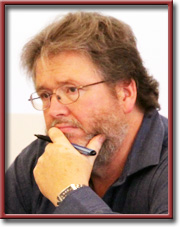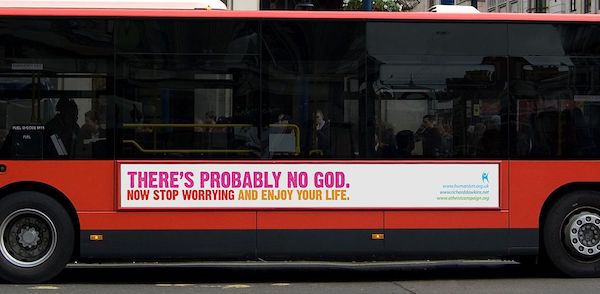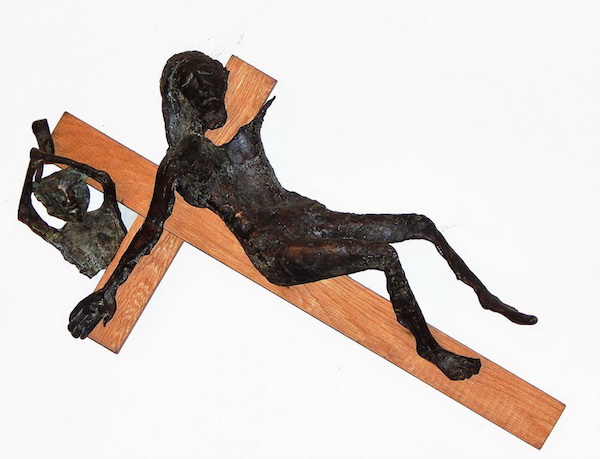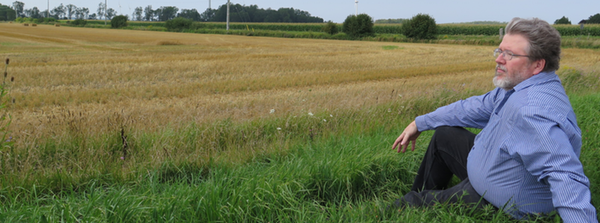Waiting, Watching, Reaching, Rising
“This stark universe forms within as well as without. It is haunted by the consequences of isolation, indifference and exploitation and by specters of fear, failure, self-hate and self-defeat. These remove us from contact and co-embodiment, encouraging us to self-differentiate into categories of immunization: users versus useless, fit versus fat, lovable versus loathsome. Notionally free individuals, we create worlds blindly; to paraphrase Marx, we make history in the freedom of delusion. Perhaps we stand poised to do the same with the end of history.”—William Ramp
Small Things Recollected
By William Ramp

 LETHBRIDGE, ALBERTA Canada—(Weekly Hubris)—May 2017— I am writing this column on the evening of what’s called Good Friday in the Christian tradition.
LETHBRIDGE, ALBERTA Canada—(Weekly Hubris)—May 2017— I am writing this column on the evening of what’s called Good Friday in the Christian tradition.
For many, this day is no more than the start of the Easter holiday weekend. While I have often attended Easter Week services, I stayed home today. But strangely, I was haunted by biblical imagery all day; by an end-times notion that the veil of some temple had been torn even as legions continued to march on the usual suspects.
I woke late this morning after overstaying a lovely social gathering in honor of a couple of graduate students finishing their degrees. In a small, windy and often parochial prairie city, a small knot of students and their teachers, gathered from four corners of the globe and many different cultures, shared food, friendship, memories and rapport, danced, and talked long into the night about aspirations, fears, issues, commitments, joys, and sorrows. Across distances in culture and language, they laughed and hugged, un-selfconsciously free in modes of expression, questioning and hunger for insight.
I couldn’t help thinking that more than one of them might have faced sanctions, prison, or even bullets in recent times or might face them in the near future. I thought of how the conversation that flowed so easily despite our varied linguistic backgrounds would be ignored by higher-education technocrats who imagine students only as rational economic actors (consumers or entrepreneurs) or as skills-receptacles. Or by dog-whistle politicians who imagine that society will collapse if thoughtful people like these are not forced to subscribe to so-called “Canadian” values held by an imagined majority.
Most of us stayed late: no-one wanted to break the spell.
But the morning after, I woke from too little sleep, tired and feeling depleted. Being alone with things undone in an overfull and under-cleaned apartment weighed on me. As the day went on, I descended a familiar take-no-prisoners spiral into paralysis and a skeptical interrogation of my past, present and likely-foreshortened future.
In an attempt to distract myself, I listlessly flipped through Facebook. As usual, its algorithmically-curated timeline juxtaposed jokes and cartoons with images of horror. The end of civilization butted up against dessert recipes, advertising, and ski trip photos. Occasional expressions of personal sadness, lack of confidence or despair were countered by messages about inspiration, potentiality, positive thinking, self-assertion, happy cats, and puppies. Most of this content seemed aimed at a demographic at least three decades younger than I.
In honor of the season, there was a crop of the usual, yearly “Did Jesus Exist?” exposés, along with recycled revelations of Easter’s pagan origins, amenable to hip-urbanist revival:
“The early church clergy also tried to put a stop to sacred cakes being baked at Easter. In the end, in the face of defiant cake-baking pagan women, they gave up and blessed the cake instead. Easter is essentially a pagan festival which is celebrated with cards, gifts and novelty Easter products, because it’s fun and the ancient symbolism still works. It’s always struck me that the power of nature and the longer days are often most felt in modern towns and cities, where we set off to work without putting on our car headlights and when our alarm clock goes off in the mornings, the streetlights outside are not still on because of the darkness.”
The take-away message this imparted reminded me of the slogan featured in the 2009 Atheist Bus campaign in London: “There’s probably no God. Now stop worrying and enjoy your life.”
Note to Eeyore-self: Think positively. Realize potential. Defy stupid stuff. Have fun.

Someone shared a video of Monty Python’s all-too-prescient satire on the Crucifixion scored to the song, “Always Look on the Bright Side of Life.” I thought recalcitrantly of Sarah Ahmed’s critique of the “imperative to be happy,” and of Sianne Ngai’s book, Ugly Feelings.
A political group shared a 2015 tweet by Christy Clark, the right-leaning premier of British Columbia who will soon face an election: “Good Friday reminds us that hard work and sacrifice are rewarded. I hope you have a restful and meaningful #Easter long weekend.”
A wag appended a sarcastic comment, “The Crucifixion and Resurrection have something to do with sacrifice and hard work.”
I scrolled through several news reports about the US military’s first combat deployment of a high-explosive device called MOAB (nicknamed “Mother of All Bombs”) against an ISIS-held cave complex in Afghanistan. Predictably, this generated a flurry of speculation, applause, condemnation, and a nationalist strut-competition over the relative lethality of MOAB versus its Russian counterpart, predictably dubbed FOAB.

Several opinion posts characterized MOAB in terms usually reserved for nuclear weapons. Others represented its use as a diversion from more sinister domestic machinations by the incumbents of the Oval Office and the Kremlin.
A few stories mentioned a US naval carrier strike force steaming toward the Korean Peninsula, noting that the North Korean leader might order a weapons test to commemorate his grandfather and political predecessor, and highlighting Chinese expressions of concern. The flat, low, menacing tones of the incumbent of the Oval Office were played over and over: “We are sending an armada. Very powerful. We have submarines. Very powerful. Far more powerful than the aircraft carrier. That I can tell you.”
One or two how-to articles with plans for simple fallout shelters were shared around, including one from the Tiny House movement, along with a map of likely strike sites.
I got up, turned on the radio, and heard a recording of the bomb blast that had decimated St. George’s (Coptic) Church in Tanta, Egypt, and the screaming that followed.
What I saw and heard was at once immediate and removed, and above all, context-free. My responses to it paralleled the jumble of its arrival. I was disturbed, worried; I re-posted and commented. But I did so distractedly.
I thought of those who counseled shutting off social media, getting out of the house, doing useful things for others face-to-face, seeking out nature: those who might characterize most of the online content that I read, share or produce as wanking. I thought about faux-concern, doing nothing, being nothing. I thought about a looming writing deadline, and past deadlines I’d missed, always promising never to do so again. I imagined a wasted day; a worthless life. I thought about the indulgence of thinking bad things about myself while others with no luxury for such rumination confronted adversity directly, rather than through the second-order discourse of a hapless Liberal self.
I forced myself to open my laptop, but thought immediately, “Who cares about the words of a fat, sluggish, reclusive old white man with the temerity to be sad in his privilege?”
I wrote this: “I feel like I have nothing to say/I feel like I have nothing/I feel like nothing/I feel nothing/Nothing.”
Thinking that I could not have been the first one to come up with this arrangement of words, I Googled them and came up with dozens of hits referring to “social anxiety syndrome.” Another self-diagnosis to add to a growing list.
It was too windy, grey, and chilly to go out, whether to contemplate suicide or to shop.

Finally, at the prompting of a social-media tag, I turned dully to YouTube, and watched the final segment of “On The Beach,” a 1959 Stanley Kramer film adaptation of a Nevil Shute novel about the slow, post-nuclear-apocalypse succumbing of humankind to the spread of radiation around the globe.
. . . and began to write.

In a penultimate scene of the film, a young man and woman, awaiting inevitable death, lie together in bed, reminiscing. They recall their meeting, moments of freedom and attraction. They share a realization that now, as they die, they have truly and mutually found love. Because this is a Hollywood film of a certain era, they are young, white, beautiful. They do not leak fluids from their eyes, mouths, noses. The bed they share is luxurious. They speak softly, secure in their privacy, and as if they have time. In the face of civilizational catastrophe, they concern themselves with a private and personal denouement.
“On The Beach” closes with shots of an emptied Melbourne, Australia. Newspapers and other detritus scooped up by wind blow through a streetscape lined with classical and Victorian brick from an era before the concrete, glass and fake-brick of today’s box-like dystopias. There are no bodies on the streets; presumably everyone had the decorum to die indoors. A final shot captures a banner still trussed to the wind: “THERE IS STILL TIME. BROTHER.”
When I read Shute’s novel as a child, I couldn’t finish it. There was no second-order abstraction of dread for me then. The Cold War weighed heavily and directly. Mass death was more than I could bear imagining, but I tried. The thought that I could die, my parents and sisters could die; we all could die, in horrible agony, enclosed me in dread and solitude. Outside, my parents entreated, “Why can’t you just be happy?” But what could I do; what could any of us do if someone we did not know flipped a switch, accidentally or on purpose, to start a world-ending catastrophe?
Do you see it? What it was that trained me so young (and others, too; I think I’m not alone in this) in isolative and passive habits of thought that still haunt bad days in my seventh decade?

MOAB may or may not be the most powerful conventional weapon in the world, but its yield is a mere .011 kilotons. By comparison, the most powerful hydrogen bomb ever detonated (the Soviet RDS-220, nicknamed Tsar Bomba) yielded 50+ megatons. Here’s a description of its effects:
“All of the wooden and brick buildings in nearby Severny, located 34 miles from the aiming point or ground zero, were annihilated. In other Soviet districts located over a hundred miles from ground zero, wooden houses were demolished, and brick and stone ones suffered damages. Radio communication outages were also reported. One test witness felt the thermal effects at a distance of 170 miles, even with dark goggles. The intense heat from the detonation was capable of causing third-degree burns at a distance of 62 miles from ground zero. The shock wave was felt as far away as the Dikson settlement located 430 miles away, and windows shattered at a distance of 560 miles. Windows even shattered as far away as Norway and Finland due to atmospheric focusing of the shock wave. Despite being an air burst detonated 13,000 feet above ground, Tsar Bomba’s seismic magnitude was estimated at 5–5.25. Seismic sensors continued to register shockwaves even after a third revolution around the Earth.”
I’m inclined to think that a catastrophe of biblical proportions is much more likely to follow from the strategic deployment of a carrier group than the tactical use of a conventional weapon. Still, my bet is that World War III will not have broken out by the time this column is published. But who’s to know what accident of technology, psychology, or geopolitics, could trigger it, or when? What small equivalent of a butterfly’s wings off the coast of Africa might unleash the final firestorm?

Many of the great antiwar and disarmament movements of the 60s are moribund. The clock of the Bulletin of the Atomic Scientists continues to fascinate, but many have been lulled by the collapse of the Soviet Union, now almost 30 years ago, into disbelieving that the current global nuclear-weapons regime is as dangerous as ever and more unstable. While angry nationalists control nuclear arsenals in more than one country, other terrors seem more immediate. And other politics—of race, gender, identity, sex, religion—consume more time and attention.
And so, while some watch for bulletins about the “armada” moving closer to the peninsula, wondering if this is it, others don’t notice them at all, attending instead to comparative measurement of personal or financial growth, fending off pervasive loneliness . . . medicalizing the existential.
Many ignore both personal and political issues to get on with the shifting necessities of day-to-day survival—in racialized and militarized civil spaces; on social assistance; in precarious employment.
We all have cause for distraction, but in different, divided and dividing ways.
There is a faux-Buddhist notion that the affairs of the world from which we seek distraction are themselves but distractions. I refuse to accept that. But it bothers me that I share in an enervation that leads the sensitive, the intimidated, the depressed, or the despairing from public concern into private and self-deprecating passivity in the face of looming catastrophe. I see it around me in friends, colleagues, even in students like those whose personae opened like flowers yesterday evening.
The only differences between me and them are that my situation is (at least for now) more secure, and that I am supposedly old enough to know better. I don’t.

In the gospels of Matthew and Mark, Christ says, from the cross, “My God, my God, why have you forsaken me?”; and, in John, “I thirst,” and then, “It is finished.”
These are not the words of someone accounting personal rewards against sacrifices. Whether you take the Crucifixion story on which this day hinges as literal truth or mythical narrative, the point of Christ’s words is clear. He felt and saw himself on the cross as alone, separated from the Godhead with whom he was later to be identified. God abased; God abandoned by God; God unable or unwilling to do a thing about God’s own predicament.
And this Jesus, who had preached the availability of a living water that would forever slake all spiritual thirst, now felt the fiery abjection of bodily dehydration and a desperate need of water, any water.
Then, finally, “It is finished”: three words which generations of apologists finessed into a statement of accomplishment, as if Jesus foreknew in that moment that a grand plan was unfolding and all was well.
He did not. I insist. He did not.
The message of the Incarnation, I would argue, is not that God became a perfect baby, a preternaturally wise and sinless child, a gifted preacher, and an escapee from death. On the cross, God become creature, not creator. God died. How and if God will be born again among us will be in large part up to those who form one broken, shared body in their mercy, in their vulnerability, in their openness . . . not in proclamations or in efforts to proclaim and immunize an identity.
The message the Crucifixion conveys to me is that God, however conceived, is in the depths this Friday (particularly) with the persecuted and self-persecuting; sitting as a witness, making space. Here, sit by me. Let’s share a drink.
The message I hear, though often obscured by static, is that no human being sits in deeper abasement than God has sat. If all stand equal and naked before God, God also died naked among us.

If this language appears too religiously-loaded, try this: no human being sits lower than humanity. Those who dehumanize do the devil’s work. To isolate is to dehumanize.
In the Ayn Randian enlightenment of neo-liberalism, the abstract opportunity to advance self-interest (in the present lingo, “personal goals”) is equally available to all. But those who fail to leverage opportunity are regarded as morally-compromised. The chance was there. Those who failed to realize its market value thereby marked themselves as worthless losers; fired from the reality show; gathered into police street kettles, into military killing-boxes, into refugee or detention camps or prisons.
This stark universe forms within as well as without. It is haunted by the consequences of isolation, indifference, and exploitation, and by specters of fear, failure, self-hate, and self-defeat. These remove us from contact and co-embodiment, encouraging us to self-differentiate into categories of immunization: users versus useless, fit versus fat, lovable versus loathsome. Notionally free individuals, we create worlds blindly; to paraphrase Marx, we make history in the freedom of delusion.
Perhaps we stand poised to do the same with the end of history.
While the date of Easter is set by the lunar calendar, both neo-pagan and Christian celebrations of the date employ sun imagery. The sun shines on all; we are all equal as creatures in the light of God. We are also equal in the sublime transparency of the nuclear blast; a human-made sun of detonation, the ultimate child of Enlightenment. Differences in wealth, status, image, race, sex, gender, age, beauty, personality, or self-esteem mean nothing to a warhead. Nor do life-hacks for survival post-blast.
The irony is that the most powerful nuclear weapon ever detonated had no use within a regime of usefulness. As the author of a post on the blog, all for dead time puts it:
“The tactical result of this escalation amounts to a weapon that would have been easily intercepted because it required slow moving bombers to transport and deploy it. The scale of the detonation is then a strategic response to its tactical ineffectiveness. By realizing its status as non-deterrent deterrent in its political purpose: that is, in the expression of an escalation towards an unrestrained bomb based on destructive size, the bomb ensures its non-use, but [also] the effectiveness of its non-use. The symbiotic reinforcement of an American-Soviet Mutually Assured Destruction leads us to a diversion of capital, of technology, beyond any meaningful end. The threat then is both non-present and omnipresent.”
In “On the Beach,” individuals, including an American naval crew, play the roles of passive and horrified spectators to the obliteration of the Northern Hemisphere. Subsequently, they find, recover, or recollect personal meaning or love in the dying circumstances of their lives; in intimate moments or in final, useless acts of individual or organizational honor.
I watch them on screen, alone.

Now, as I finish writing, it’s Holy Saturday; traditionally a day to recall the Harrowing of Hell, Christ’s descent to the realm of the dead to call forth all the righteous who had died since the beginning of the world. I interpret “the righteous” not as “believers” but as those who’ve felt hell in their own or others’ bones, and have offered or cried out for a hand. Those who did not die instantly at Hiroshima and Nagasaki; those who grew up in dread and into paralysis; those who suffer self-defeat in the grip of monsters labeled with a pharmacopeia of categories that now includes ecological stress disorder.

What hands are extended for such as these to grasp? How can hands and voices be rejoined to dispel morbid spectatorship and the regimes to which it cedes public space? I struggle with that question; I’m not at Easter Sunday yet.
Maya Angelou provided one answer in the poem, “Still I Rise”: “Leaving behind nights of terror and fear/I rise/Into a daybreak that’s wondrously clear/I rise/Bringing the gifts that my ancestors gave,/I am the dream and the hope of the slave./I rise/I rise/I rise.”
Angelou rose, in part, through her own strengths. Katherine Fritz, with whose perspective I often identify, has a keen sense of the weaker ones; those who fail to grasp, see or even imagine their strengths or offered hands. Like me, she “fell out of attending church services,” but hasn’t “shaken the habit of reflecting upon certain events with ritualistic precision.” In “Rise,” she writes,
“Some years, I think about Pontius Pilate. How he gave the people a choice: free Barabbas, or crucify Jesus. How the people voted. How the people won.
“Some years, I think about his friends. How they laid low, afraid to publicly grieve and mourn, for fear that they could be next. How understandable that impulse is.
“Some years, I think about the rest of Judea. The folks not really portrayed in the story, the background extras. All the people shopping and cooking and bathing and eating and sleeping and raising their kids and working at their jobs, those for whom crucifixions were just, like, a thing that happens on Fridays.
“I think about the other dudes being tortured on the crosses next to Jesus, and I wonder how we live in a country that still executes criminals. I wonder how many people who support this policy are in church today, singing Hallelujah, He is Risen.
“I think about the protests yesterday, how people peacefully gathering in large groups is still considered a threat to those in power. I wonder if there will be more betrayals. More decisions rooted in fear.
“I wonder who will listen to this story, and I wonder how it will be remembered. I wonder what this story says about us, when we gather and listen to it. I wonder what we remember. I wonder what we forget.
“Hallelujah. Rise.”
Resisting destruction of the natural and human world, the militarization of civil society, and the nuclearization of politics might be our final possibilities for collective honor. In the time that remains, how do we best make spaces and ways, large or small, to reach for, hold, talk to, dance with and act with others across borders, cultures and languages, trespassing walls that leaders erect and immunities that we police?
Can we name accurately and disarm the central engines of fear, division, retaliation, destruction? Can we disarm ourselves in the light of each other, seeing public and personal life as co-dimensions of one body? Can we resist human sacrifice to the zero-sum worship of success, innovation, atomized self-sufficiency, consumerist self-care, safety? How do we crack the tyrannies of usefulness and accountability metrics; the individualization of responsibility and fate?
I don’t always know or believe that hands reach for me, but I reach for them as I’m able, seeking and pleading a case for mutual and mutually-merciful resistance enacted within and beyond individuals; resistance to regimes of extraction, use, and death, to America First-ism, me first-ism, I’m fine-ism.
Resurrection from a dead marriage of privatized shame to public fatalism.
For rising together.

About the Illustrations
Image 1 “BADGER test detonation, April 18, 1953, at Nevada Test Site.” From Wikimedia Commons: https://commons.wikimedia.org/wiki/File:Operation_Upshot-Knothole_-_Badger_001.jpg Public domain; held by National Nuclear Security Administration.
Image 2 “Atheist advertisement on a London General bus, 2008.” Photo by Dan Etherington, sourced from Wikimedia Commons: https://commons.wikimedia.org/wiki/File:Atheist_Bus_Campaign_Citaro.jpg Reproduced under Creative Commons Attribution 2.0 Generic License.
Image 3 “A GBU-43/B Massive Ordnance Air Blast (MOAB) weapon, Air Force Armament Museum, Eglin Air Force Base, Florida.” Photo by FI295, sourced from Wikimedia Commons: https://commons.wikimedia.org/wiki/File:MOABAFAM.JPG Public domain.
Image 4 “Film poster for ‘On The Beach’ (1959).” From Wikipedia: https://en.wikipedia.org/wiki/File:Onethebeach.jpg Used under fair use statement as follows: The poster is being used for informational purposes only, and its use is not believed to detract from the original film in any way.
Image 5 “USS Carl Vinson (CVN-70) underway in the Pacific Ocean, May 2015.” From Wikimedia Commons: https://commons.wikimedia.org/wiki/File:USS_Carl_Vinson_(CVN-70)_underway_in_the_Pacific_Ocean_on_31_May_2015.JPG Public domain.
Image 6 “Bettina Sabbatini, ‘Station 9: Jesus is crucified,’ Stations of the Cross, Église Saints-Pierre-et-Paul (Bertrange), Luxemburg.” Photo (2016) by Sultan Edijingo, from Wikimedia Commons:
https://commons.wikimedia.org/wiki/File:B_Sabbatini_Kr%C3%A4izwee9.jpg Used under Creative Commons Attribution-Share Alike 4.0 International license.
Image 7 “‘Christ’s Descent into Limbo’, Andrea Mantegna & studio, c. 1470.” From Wikimedia Commons: https://commons.wikimedia.org/wiki/File:MantegnaDescentLimbo.jpg Public Domain as a faithful photographic reproduction of a two-dimensional, public domain work of art.
Sources & Notes Regarding Quotations
… so-called “Canadian” values … Richard Warnica, “Is Kellie Leitch For Real?” National Post, January 18, 2017: http://news.nationalpost.com/features/is-kellie-leitch-for-real
… messages about inspiration, potentiality, positive thinking, self-assertion … Maria Popova, “The Art of Motherfuckitude: Cheryl Strayed’s Advice to an Aspiring Writer on Faith and Humility.” Brain Pickings, April 13, 2015: https://www.brainpickings.org/2015/04/13/cheryl-strayed-write-like-a-motherfucker-advice/
… revelations of Easter’s pagan origins … Heather McDougall, “The Pagan Roots of Easter.” The Guardian, April 3, 2010: https://www.theguardian.com/commentisfree/belief/2010/apr/03/easter-pagan-symbolism?CMP=fb_gu
… atheist bus campaign … Riazat Butt, “Atheist bus campaign goes nationwide.” The Guardian, January 6, 2009: https://www.theguardian.com/world/2009/jan/06/religion-atheist-bus-campaign-national
… Sarah Ahmed’s critique of the “imperative to be happy” … Sarah Ahmed, The Promise of Happiness, Duke University Press, 2010: https://www.dukeupress.edu/the-promise-of-happiness
… Sianne Ngai’s book, Ugly Feelings … Sianne Ngai, Ugly Feelings, Harvard University Press, 2007: http://www.hup.harvard.edu/catalog.php?isbn=9780674024090
… a 2015 tweet by Christy Clark … Reproduced in a post to the Facebook page, Stop the BC Liberals, April 14, 2017: https://www.facebook.com/stopbcliberals/posts/1468741569823528
… U.S. military’s first combat deployment of a high-explosive device called MOAB … Sune Engel Rasmussen, “US ‘mother of all bombs’ killed 92 Isis militants, say Afghan officials.” The Guardian, April 15, 2017: https://www.theguardian.com/world/2017/apr/15/us-mother-of-all-bombs-moab-afghanistan-donald-trump-death-toll
… a nationalist strut-competition over the relative lethality of MOAB versus its Russian counterpart … Matthew Bodner, “Dear America, Russia Wants You to Know Its Bombs Are Bigger.” The Moscow Times, April 14, 2017: https://themoscowtimes.com/articles/dear-america-russia-wants-you-to-know-its-bombs-are-bigger-57732
… a U.S. naval carrier strike force steaming toward the Korean Peninsula … Samuel Osborne, “Donald Trump’s ‘armada’ steams on as North Korea warns of nuclear strike on US.” Independent, April 12, 2017: http://www.independent.co.uk/news/world/asia/donald-trump-north-korea-armada-nuclear-strike-us-navy-strike-group-fleet-aircraft-carrier-china-a7679586.html
… highlighting Chinese expressions of concern … Anna Fifield, “North Korea warns world is on brink of ‘thermo-nuclear war’ because Trump is ‘always making provocations’.” National Post (via Washington Post), April 14, 2017: http://news.nationalpost.com/news/world/north-korea-warns-of-thermo-nuclear-war
… including one from the Tiny House movement … “How To Design A Nuclear Fallout Shelter.” Tiny House DESIGN, n.d. (2011?): http://www.tinyhousedesign.com/how-to-design-a-nuclear-fallout-shelter/
… a map of likely strike sites … John Dodge, “Best Places To Survive A Nuclear Apocalypse?” CBS Chicago, March 19, 2015: http://chicago.cbslocal.com/2015/03/19/best-places-to-survive-a-nuclear-apocalypse/
… the bomb blast that had decimated St. George’s (Coptic) Church in Tanta, Egypt … Samuel Osborne, “Egypt church bombings: At least 44 killed in two explosions targeting Christians on Palm Sunday.” Independent, April 9, 2017: http://www.independent.co.uk/news/world/middle-east/church-bombing-cairo-egypt-tanta-kills-dead-wounded-injured-latest-a7674761.html
… the final segment of On the Beach … “On The Beach 1959 Ending,” posted to YouTube, July 1, 2015: https://www.youtube.com/watch?v=lNju8IjExn4
… Stanley Kramer film adaptation of a Nevil Shute novel … Nevil Shute, On The Beach, House of Stratus, 2002 (first published 1957), Goodreads: http://www.goodreads.com/book/show/38180.On_the_Beach
… the most powerful hydrogen bomb ever detonated … “Tsar Bomba,” Atomic Heritage Foundation, August 8, 2014: http://www.atomicheritage.org/history/tsar-bomba
… a description of its effects … “Tsar Bomba,” Atomic Heritage Foundation, August 8, 2014: http://www.atomicheritage.org/history/tsar-bomba
… disbelieving that the current global nuclear-weapons regime is as dangerous as ever … Paul Mason, “Nuclear war has become thinkable again – we need a reminder of what it means.” The Guardian, April 17, 2017: https://www.theguardian.com/commentisfree/2017/apr/17/nuclear-war-has-become-thinkable-again-we-need-a-reminder-of-what-it-means
… life-hacks for survival post-blast … Patrick Allan, “Where to Hide If a Nuclear Bomb Goes Off In Your Area.” lifehacker, March 21, 2017: http://lifehacker.com/where-to-hide-if-a-nuclear-bomb-goes-off-in-your-area-1793493053
… a post on the blog, all for dead time … “Explosive aesthetics: adorno & the art of detonation.” all for dead time, May 7, 2010: https://allfordeadtime.wordpress.com/2010/05/07/explosive-aesthetics-adorno-the-art-of-detonation/
… a pharmacopeia of categories that now includes ecological stress disorder … Michael Wright, “A Closer Look: Ecological Stress Disorder.” ecoAmerica, April 6, 2017: https://ecoamerica.org/2017/04/closer-look-ecological-stress-disorder/?utm_content=bufferbda0f&utm_medium=social&utm_source=linkedin.com&utm_campaign=buffer
… Maya Angelou provided one answer in the poem, “Still I Rise” … Maya Angelou, “Still I Rise.” Reproduced on Poetry Foundation: https://www.poetryfoundation.org/poems-and-poets/poems/detail/46446
… In “Rise,” she writes … Katherine Fritz, “Rise.” I Am Begging My Mother Not To Read This Blog, April 16, 2017: https://iambeggingmymothernottoreadthisblog.com/2017/04/16/rise/
… Can we resist human sacrifice to the zero-sum worship of success … Giles Fraser, “Christianity, when properly understood, is a religion of losers.” The Guardian, 3 April, 2015: https://www.theguardian.com/commentisfree/belief/2015/apr/03/christianity-when-properly-understood-religion-losers
